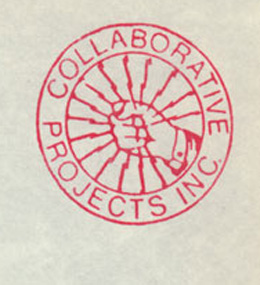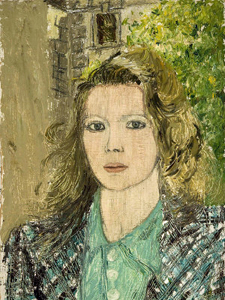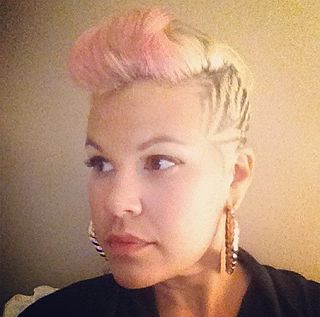Related Research Articles
Martha Rosler is an American artist. She is a conceptual artist who works in photography and photo text, video, installation, sculpture, and performance, as well as writing about art and culture. Rosler's work is centered on everyday life and the public sphere, often with an eye to women's experience. Recurrent concerns are the media and war, as well as architecture and the built environment, from housing and homelessness to places of passage and systems of transport.

Anni Albers was a German textile artist and printmaker credited with blurring the lines between traditional craft and art.
Besides surface qualities, such as rough and smooth, dull and shiny, hard and soft, textiles also includes colour, and, as the dominating element, texture, which is the result of the construction of weaves. Like any craft it may end in producing useful objects, or it may rise to the level of art.

Colab is the commonly used abbreviation of the New York City artists' group Collaborative Projects, which was formed after a series of open meetings between artists of various disciplines.

The feminist art movement in the United States began in the early 1970s and sought to promote the study, creation, understanding and promotion of women's art. First-generation feminist artists include Judy Chicago, Miriam Schapiro, Suzanne Lacy, Judith Bernstein, Sheila de Bretteville, Mary Beth Edelson, Carolee Schneeman, Rachel Rosenthal, and many other women. They were part of the Feminist art movement in the United States in the early 1970s to develop feminist writing and art. The movement spread quickly through museum protests in both New York and Los Angeles, via an early network called W.E.B. that disseminated news of feminist art activities from 1971 to 1973 in a nationally circulated newsletter, and at conferences such as the West Coast Women's Artists Conference held at California Institute of the Arts and the Conference of Women in the Visual Arts, at the Corcoran School of Art in Washington, D.C..

Sylvia Sleigh was a Welsh-born naturalised American realist painter who lived and worked in New York City. She is known for her role in the feminist art movement and especially for reversing traditional gender roles in her paintings of nude men, often using conventional female poses from historical paintings by male artists like Diego Vélazquez, Titian, and Jean-Auguste-Dominique Ingres. Her most well-known subjects were art critics, feminist artists, and her husband, Lawrence Alloway.

Pat Steir is an American painter and printmaker. Her early work was loosely associated with conceptual art and minimalism, however, she is best known for her abstract dripped, splashed and poured "Waterfall" paintings, which she started in the 1980s, and for her later site-specific wall drawings.

Barbara Ann Rosenthal is an American avant-garde artist, writer and performer. Her existential themes have contributed to contemporary art and philosophy. Her pseudonyms include "Homo Futurus," taken from the title of one of her books and "Cassandra-on-the-Hudson," which alludes to "the dangerous world she envisions" while creating art in her studio and residence, located since 1998 on the Hudson River in Greenwich Village, NYC. She successfully trademarked "Homo Futurus" in 2022.
Marylyn Dintenfass is an American painter, printmaker, and sculptor. She is primarily known for her oil paintings, which use a dynamic color palette and lexicon of gestural imagery to explore dualities in the human experience and everyday sensual pleasures.

Heather T. Hart is a visual artist who works in a variety of media including interactive and participatory Installation art, drawing, collage, and painting. She is a co-founder of the Black Lunch Table Project, which includes a Wikipedia initiative focused on addressing diversity representation in the arts on Wikipedia.

Howardena Pindell is an American artist, curator, and educator. She is known as a painter and mixed media artist, her work explores texture, color, structures, and the process of making art; it is often political, addressing the intersecting issues of racism, feminism, violence, slavery, and exploitation. She is known for the wide variety of techniques and materials used in her artwork; she has created abstract paintings, collages, "video drawings," and "process art."

Margia Kramer is an American documentary visual artist, writer and activist living in New York. In the 1970s and 1980s, Kramer recontextualized primary texts in a series of pioneering, interdisciplinary multi-media installations, videotapes, self-published books, and writings that focused on feminist, civil rights, civil liberties, censorship, and surveillance issues.
Robin Winters is an American conceptual artist and teacher based in New York. Winters is known for creating solo exhibitions containing an interactive durational performance component to his installations, sometimes lasting up to two months. As an early practitioner of Relational Aesthetics Winters has incorporated such devices as blind dates, double dates, dinners, fortune telling, and free consultation in his performances. Throughout his career he has engaged in a wide variety of media, such as performance art, film, video, writing prose and poetry, photography, installation art, printmaking, drawing, painting, ceramic sculpture, bronze sculpture, and glassblowing. Recurring imagery in his work includes faces, boats, cars, bottles, hats, and the fool.

Mary Miss is an American artist and designer. Her work has crossed boundaries between architecture, landscape architecture, engineering and urban design. Her installations are collaborative in nature: she has worked with scientists, historians, designers, and public administrators. She is primarily interested in how to engage the public in decoding their surrounding environment.
Martha Neill Upton was a watercolorist, sculptor and studio quilt artist. Her quilted tapestries helped quilts become seen as fine art, rather than craft work, during the early 1970s. Her quilts were shown in the first major museum exhibition of non-traditional quilts, The New American Quilt at New York's Museum of Arts and Design, then called the Museum of Contemporary Craft, in 1976.
June Druiett Blum was a multimedia American artist who produced paintings, sculptures, prints, light shows, happenings, jewelry, art books, pottery, conceptual documentations, and drawings. She was also a feminist curator and activist who worked to advance the women's movement and increase visibility for women artists.
Ann Gillen is an American sculptor.

Ronald Markman was an American artist and educator best known for producing large colorful paintings and sculptures in a style that combined elements of Surrealism and pop art with a deep grounding in color theory. He integrated classical and popular culture, humor, as well as whimsy and riotous color to deliver social satire and a deeply personal vision of the world.
Elke Solomon is an artist, curator, educator and community worker. She is known for her interdisciplinary practice that combines painting, drawing, object-making, performance and installation. She has exhibited widely in the United States and abroad.

Suzi Ferrer, also known as Sasha Ferrer, was a visual artist based in San Juan, Puerto Rico from the mid-1960s to 1975. She is known for her transgressive, irreverent, avant-garde, art brut and feminist work.
Jonathan Green is an American writer, historian of photography, curator, teacher, museum administrator, photographer, filmmaker and the founding Project Director of the Wexner Center for the Arts. A recognized authority on the history of American photography, Green’s books Camera Work: A Critical Anthology (1973) and American Photography: A Critical History 1945–1980 (1984) are two notable commentaries and frequently referenced and republished accounts in the field of photography. At the same time Green’s acquisitions, exhibitions and publications consistently drew from the edges of established photographic practice rather than from its traditional center. He supported acquisitions by socially activist artists like Adrian Piper and graffiti artist Furtura 2000, and hosted exhibitions on Rape, AIDS, new feminist art, and the work of photographer, choreographer and dancer Arnie Zane, the Diana camera images of Nancy Rexroth, the Polaroids and imitation biplanes of folk artist Leslie Payne, and the digital photographic work of Mexican photographer Pedro Meyer. This alternative focus help prime Green and the competition jury to choose an unconventional, deconstructive architect, Peter Eisenman, previously known primarily as a teacher and theorist, as the architect for the Wexner Center for the Arts. Green has held professorial and directorial positions at Massachusetts Institute of Technology, Ohio State University, and University of California, Riverside.
References
- 1 2 3 4 MacDowell. "Susan Kaprov". MacDowell Artists: Susan Kaprov. Retrieved April 8, 2021.
- 1 2 3 Frank, Peter (Fall 1976). "Reviews: Susan Kaprov" (PDF). Women Art Magazine. Retrieved April 8, 2021. p 28.
- ↑ "Susan Kaprov 1946-". Whitney Museum of American Art. Retrieved April 8, 2021.
- ↑ "Prints & Portfolios Published". The Print Collector's Newsletter. 6 (2): 43–45. May–June 1975. JSTOR 44129898 . Retrieved April 7, 2021. Vol. 6, No. 2, p. 44.
- ↑ Joyce Kozloff, Judy Seigel, Shirley Fuerst, Pat Passlof, Therese Schwartz, and Susan Schwalb (September 1975). "Group Shows: C.W. Post Art Faculty Invitational Exhibition". JSTOR. Retrieved April 7, 2021.
{{cite web}}: CS1 maint: multiple names: authors list (link) Women's Art Newsletter, Vol. 1, No. 4, p. 2. - ↑ "Prints: Acquisitions, 1973–1976 Image 4". MoMA Prints: Acquisitions, 1973-1976. November 1976. Retrieved April 8, 2021.
- ↑ "Prints: Acquisitions 1973-1976" (PDF). The Museum of Modern Art. 26 November 1976. Retrieved April 8, 2021. No. 97.
- ↑ "The Print Collector's Newsletter". JSTOR. Art in Print Review. 9 (4): 120–124. September–October 1978. JSTOR 44130448 . Retrieved April 8, 2021. Vol. 9, No. 4, p. 122-23.
- 1 2 "Solo Shows: Susan Kaprov". Independent Voices: Women Artists Newsletter. November 1978. Retrieved April 7, 2021.Vol. 4, No. 5, p. 5.
- ↑ "Arts & Leisure Guide". The New York Times. 19 March 1978. Retrieved April 8, 2021.
- ↑ "20th Century Dilemma I by Susan Kaprov, 1980-81". The Brooklyn Museum. Retrieved April 8, 2021.
- 1 2 Lubell, Ellen. “Susan Kaprov at the Brooklyn Museum.” Art in America, December 1981, 146.
- ↑ Business to Business.“Photomontages Enliven Public Spaces,” June/July 1989, 42.
- ↑ "Susan Kaprov". Palm Desert Artist Registry. Retrieved April 8, 2021.
- ↑ "Urban Helix by Susan Kaprov". New York University. 2014. Retrieved April 8, 2021.
- 1 2 "Susan Kaprov, Artwork by Susan Kaprov". University of Iowa. 2011. Retrieved April 8, 2021.
- ↑ University of Iowa Media Production (3 October 2011). "Going the Distance by Susan Kaprov". YouTube. Retrieved April 8, 2021.
- ↑ Frisch, Cari (6 March 2013). "Piecing It Together: A Family Artist Talk with Susan Kaprov". Inside/Out at the Museum of Modern Art. Retrieved 6 April 2021.
- ↑ "Susan Kaprov, Brooklyn NY". BRIC Artist Registry. Retrieved April 8, 2021.
- ↑ "Las Vegas: Arts in Transit Along the Sahara Express". Infrastructure USA. December 2013. Retrieved April 8, 2021.
- ↑ "Strange Mirror, 1989 by Susan Kaprov". The Metropolitan Museum of Art. Retrieved April 8, 2021.
- ↑ "MoMA Art and Artists: Susan Kaprov, American, born 1946". The Museum of Modern Art. Retrieved April 8, 2021.
- ↑ Smithsonian. "Susan Kaprov". Archives of American Art. Retrieved April 8, 2021.
- ↑ "Susan Kaprov". The Brooklyn Museum. Retrieved April 8, 2021.
- ↑ "Photographs, Self-Portrait, Solo, Susan Kaprov". The Rose Art Museum. Retrieved April 8, 2021.
- ↑ "Catalogue of the Sylvia Sleigh Collection" (PDF). Rowan University Art Gallery. Retrieved April 8, 2021.
- ↑ "Susan Kaprov". Visual Studies Workshop. Retrieved April 8, 2021.
- ↑ Edmunds, Allan (2004). "Three Decades of American Printmaking: The Brandywine Workshop Collection". pp. 199, 218. ISBN 978-1555952419.
- ↑ Smithsonian. "Dintenfass, Terry: Kaprov, Susan, 1978-1979". Archives of American Art. Retrieved April 8, 2021.
- ↑ CUE The Weekly Magazine of New York Life (1978). "Galleries: Hayden Planetarium: White Light Drawings by Susan Kaprov thru April 30th". Cue Publishing Company. Retrieved April 8, 2021. 239.
- ↑ "Exhibitions: CAPS Grantees from Brooklyn". The Brooklyn Museum. April–June 1981. Retrieved April 8, 2021.
- ↑ "ART: Museums: Brooklyn Museum: Susan Kaprov Twentieth Century Dilemma thru 6/7...CAPS Grantees From Brooklyn thru 6/7". New York Magazine. 8 June 1981. Retrieved April 8, 2021. p 82.
- ↑ ""Almanac: Solo Exhibitions: Susan Kaprov: Compositions for Night, paintings, drawings, cartoons"". Independent Voices: Women Artists Newsletter. June 1987. Retrieved April 7, 2021. Vol. 12, No. 2, 6.
- ↑ "SUSAN KAPROV: Nature...last modified". Stamford Museum & Nature Center. June–July 2000. Retrieved April 8, 2021.
- ↑ Chamness, Monica (20 March 2002). "Artwork the Final Touch for U.S. Courthouse". Jacksonville Daily Record. Retrieved April 8, 2021.
- ↑ "Green Hill Center in Greensboro, NC, Offers Exhibitions to Celebrate NC's Wright Brothers' Celebration". Carolina Arts. July 2003. Retrieved April 8, 2021.
- ↑ Rodengen, Jeffrey L. (2003). "Polytechnic University. Changing the First 150 Years" (PDF). New York University, Tandon School of Engineering. Retrieved April 8, 2021. p 392
- ↑ "In Memoriam: David Stoler". The Optical Society. 25 April 2018. Retrieved April 8, 2021.